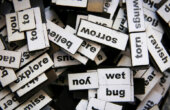An Illustrated Guide to Mouth Gestures and Their Meanings Around the World
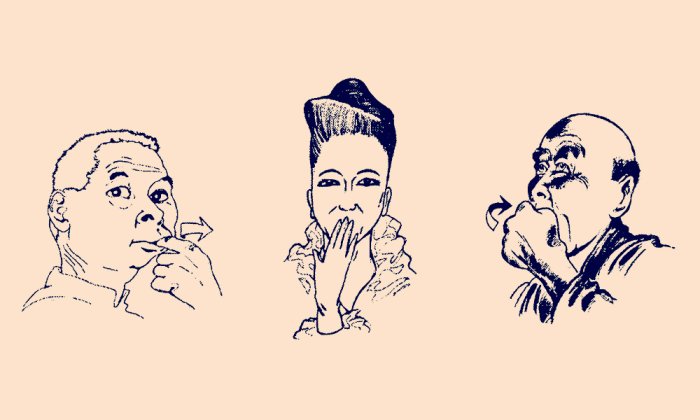
We might believe that the seat of speech (without considering ventriloquists and flatulists) has no need for the assistance of hand gestures when it comes to expressing emotions and sensations. Numerous adjectives confirm this to be true: foul, open, loud, smart, foaming, pouty, watering — the mouth can be all of these things and many more still.
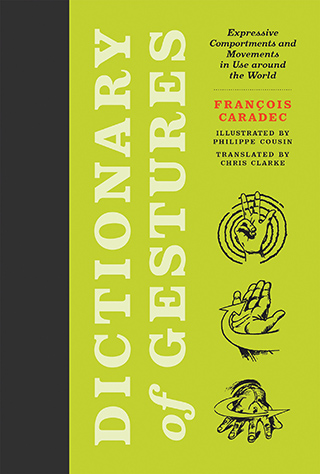
Whereas in English, to have your heart in your mouth means to be very nervous, in French, it is inverted and has a different meaning. As Raymond Queneau puts it in “Loin de Rueil”: “He coldly left like in a transitional scene, just like that, in the night, mouth in heart, without a word.” Typically, in French, this means to put on airs or to simper.
The French also have the expression la bouche en cul de poule, which literally means “to have a chicken’s ass for a mouth,” but idiomatically indicates that someone has put on a honeyed or fawning look, puckering his lips or not, in the hopes of getting what he wants. The mouth can be mysterious and arouse fantasies, which Simone de Beauvoir acknowledged in her book “Memoirs of a Dutiful Daughter”:
I would have very much liked to find out through what mechanism it was that the contact of two mouths brought about sensual pleasure: often, looking at the lips of a young man or a young woman, I was amazed.
The mouth also knows how to keep quiet: It is upon the mouth that the monkey of Chinese wisdom places its hands to signify that silence is always worth more than an imprudent word.

1 / to touch the index finger to one’s lips
Silence. Do not make noise; be quiet.
In the Arab world, one blows on the finger.
“Then recommending me, by an impressive gesture, to keep silence, he went into the boat which awaited him.”
—Jules Verne, “A Journey into the Interior of the Earth,” trans. F. Malleson, 1877
2 / to bring two or three fingers, pinched together, to the mouth several times
Hunger. This is the most widespread sign of hunger, used to ask for food to eat.
3 / to bring one’s hand to one’s mouth in the shape of a small vessel, the thumb and index finger touching in a circle, the whole in imitation of a cup from which to drink
Thirst. “I need something to drink! I’m thirsty!”
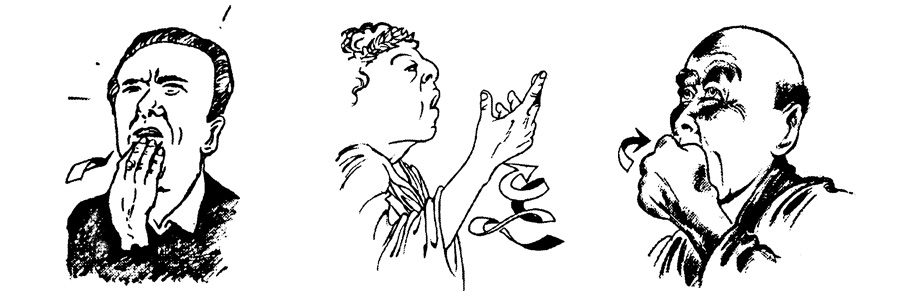
4 / to bring one’s hand toward one’s mouth as if to hold in one’s speech
Indignation; surprise. A gesture of eloquence.
5 / to bring one’s hand toward one’s mouth without quite touching it
Modesty. A gesture of eloquence employed by the great orators of antiquity.
6 / to bring one’s fist to one’s mouth
A regional variant of the previous example. Arab world, but has equally been adopted in monasteries.
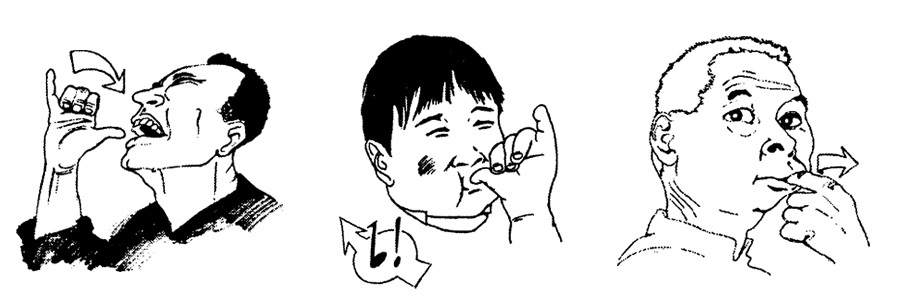
7 / to raise a half-closed fist with the pinky jutting out to the front, the thumb turned toward the mouth, head tipped back
Thirst. A gesture that signifies drinking straight from a bottle or wineskin: “Bring me something to drink! I’m thirsty!”
Mediterranean world.
8 / to feign putting one’s lips to a trumpet formed by the closed fist, thumb turned toward the mouth, little finger stuck out to the front.
Trumpet. Children’s game. But also mockery with regard to a pretentious individual.
9 / to insert the index finger into the mouth and use it to make the cheek “pop”
To make a face. Mockery. “Panurge bobbed and made mouths at him in token of derision” (Rabelais, “The Works of Rabelais, Book IV,” trans. Motteux, 1708). Called la babou in French, named for a witch with great big lips.
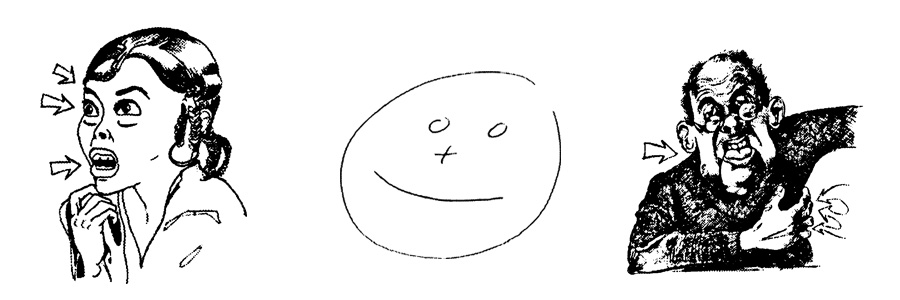
10 / to open one’s mouth, raise one’s eyebrows, and widen one’s eyes
Astonishment. A universal expression, according to Darwin, in “The Expression of the Emotions in Man and Animals,” 1872.
11 / to smile
The smile, like laughter, is unique to humankind. It isn’t always involuntary, but is quite often forced. This is what we might refer to as “the salesman’s smile,” or the carnivorous smile of the politician on the campaign trail. According to Klineberg, the smile in Melanesia expresses sadness. In Asia, it is wiped away the moment the interlocutor becomes interested in the conversation.
12 / to inflate the lower jaw area while pushing one’s tongue out from between the teeth and lips, at the same time as scratching one’s armpits
Mockery. A gesture imitating the monkey scratching itself.
“Maïb-Awls inflated the lower part of his mouth and wedged his tongue between his lower jaw and the skin, scratching his armpits at the same time.”
—Jacques Jouet, “The Republic of Maïb-Awls”
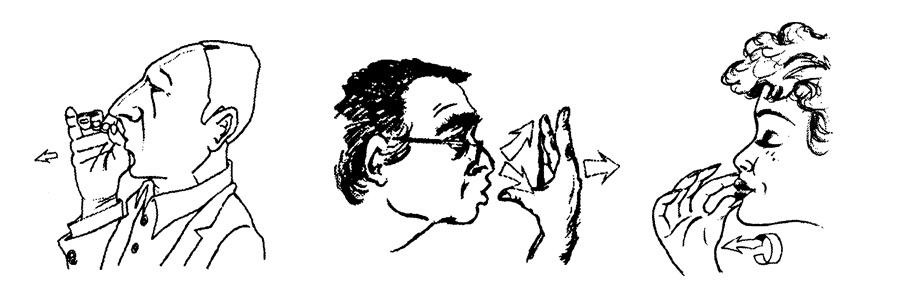
13 / the hand forming a cone before the mouth
To whisper a secret; to call quietly to someone.
14 / the right hand, with all five fingers gathered together, is touched to one’s mouth, the lips puckered, and then partially opened while the hand abruptly pulls away with a “pschitt!” of pleasure
Exquisite, delicious.
Italy.
15 / the hand open, pinching the edge of the lips between the thumb and index finger, only to pull them away abruptly
A variant of the previous example. Exquisite, delicious. A gesture to be made after having tasted a dish.
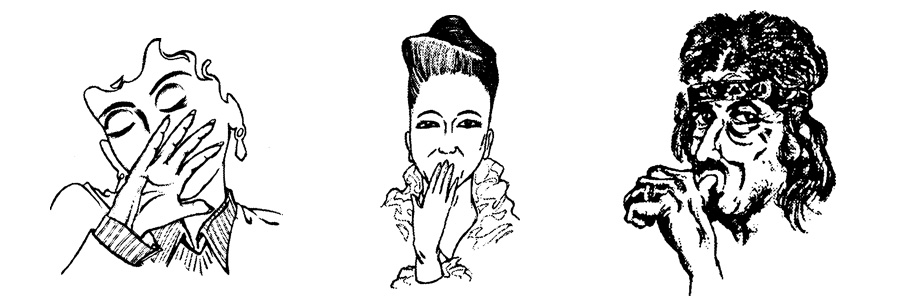
16 / the hand in front of the mouth, fingers slightly spread, palm facing out
Confusion; shyness.
A gesture common among young girls in North America.
17 / the hand in front of the mouth, palm turned toward the face
A variant of the previous example. Enthusiasm. “How adorable!” (“The Behaviors of Paris,” mimed French chanson from the 18th century.)
18 / to thrust one’s thumb into the mouth, inflate the cheeks, and blow
Indifference. Defiance, disregard for danger.
The Netherlands.
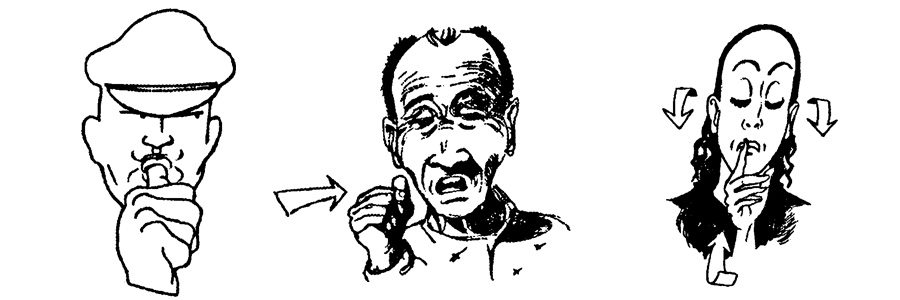
19 / to suck the tip of one’s thumb
Immaturity. Mockery directed to an interlocutor that suggests he has remained a child and still sucks his thumb.
In the Netherlands, this gesture can also signify that one’s interlocutor is a liar.
20 / the hand folded as if it is holding something (food) with the fingertips, brought quickly to the mouth
Hunger.
21 / to place the tip of one’s index finger on the lips while lowering one’s eyes
Contrition. Regret.
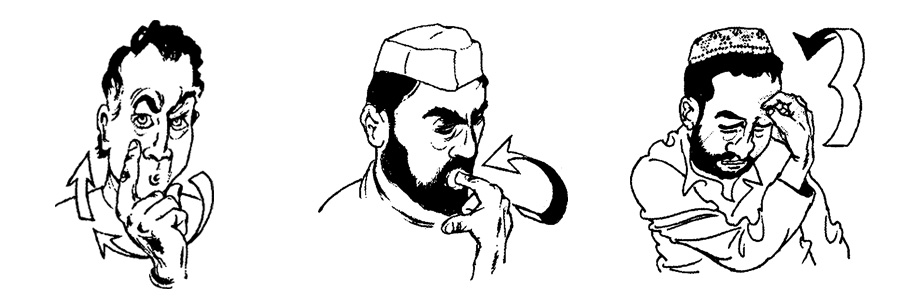
22 / to insert one’s middle finger into one’s mouth through pinched lips, then to remove it and hold it up for an interlocutor
Obscene gesture. Threat of sodomy. Insult.
23 / to place one’s index finger in one’s mouth and to quickly suck at it
Misery. Lack of money.
Arab world.
24 / to touch one’s lips with the tips of the thumb, index, and middle fingers, then to touch them to one’s forehead while slightly tilting the head
“Salaam!” A simplified version of the Arab greeting, which is accompanied by the words “Salaam alaikum” (Peace be upon you).
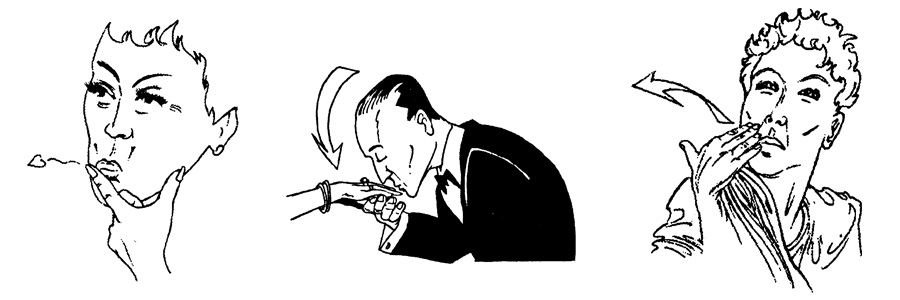
25 / to kiss the tip of one’s index finger
To kiss from afar. A kiss farewell.
“Suddenly, Mlle. de Cardoville laid her finger upon her lips,
blew a couple of kisses in the direction towards which she
had been looking, and all at once disappeared.”
—Eugène Sue, “The Wandering Jew,” trans. anon., 1889
In another variant, the kiss is then placed on the lips of the loved one.
“She kissed her fingers and touched Griff’s lips.”
—Timothy Findley, “Spadework”
26 / lightly holding a woman’s right hand, the man bends down and feigns placing a kiss on the joints of her fingers
Gallantry. This gesture is the kiss of the hand. It must be executed without a sound from the lips, lightly, and rather quickly. This homage meets the rules of international etiquette. It can also be used on the hand of a sovereign or a high-ranking religious dignitary.
“She … held out to him her fingers with their pale nails, the back of her hand facing up. Simon was not in the habit of kissing hands. He lifted her wrist belatedly. A faint smile, the first she had worn since the beginning of the interview, appeared on the lips of Mme Eterlin.”
—Maurice Druon, “The Great Families,” 1948
These days, this gesture has become a sign of affectation, sullied by ridicule. The usage of this gesture by the French, well on its way to disappearing, has been the cause of much laughter by Americans. This is corroborated by a photograph of President Jacques Chirac kissing the hand of Condoleezza Rice.
to kiss another’s hand while giving a slight bow
This variation is a sign of profound respect. This gesture seems currently to be reserved for use by the subjects of the King of Morocco, but it adapts very well to use with any other sitting monarch or dictator. It is equally a sign of respect for the Queen of England.
27 / to brush one’s lips with one’s fingertips, then move the hand away from the mouth as if to throw the kiss to the person it is intended for
Admiration.
A gesture known to the Greeks and Romans of antiquity: back then it was a gesture of adoration offered to a deity.
Used in Europe, with the exception of the Anglo-Saxon countries.
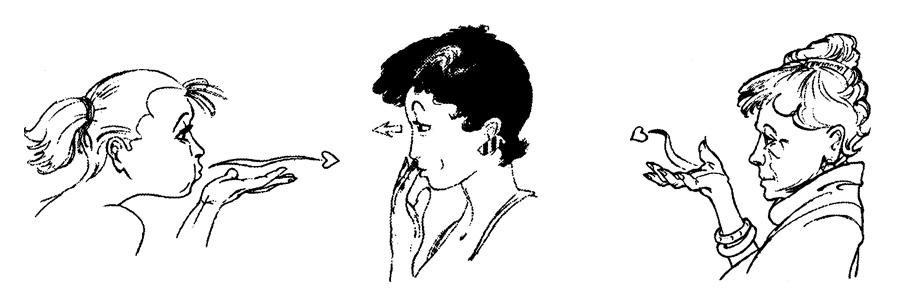
28 / to place a kiss on one’s fingertips and, with the hand flat and palm up, to blow the kiss in the direction of the man or woman to whom it is being sent
Admiration. To blow someone a kiss.
“Maïb-Awls placed his right hand upon his heart, removed it, placed it horizontally in front of his mouth, fingers directed at Brout’, and blew.”
—Jacques Jouet, “The Republic of Maïb-Awls”
29 / to kiss one’s hand while looking at a loved one
Long-distance kiss. Admiration. Adoration.
30 / to place a kiss on the palm of one’s hand, held vertically against the face, then to hold it out toward a loved one
Admiration. Adoration.
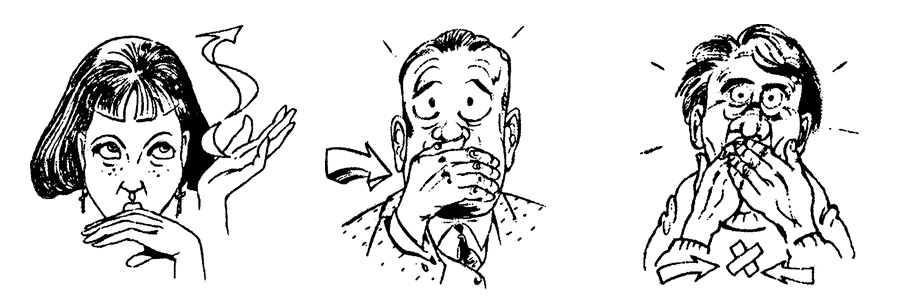
31 / to kiss the knuckles of the back of one’s own hand, then to turn the palm skyward while raising the eyes to the heavens
Worship, adoration. Prayer of gratitude.
Arab world.
32 / to quickly cover one’s mouth with one’s hand
a. A blunder. “That just slipped out.” Placing one’s hand over one’s mouth prevents one from saying anything further.
b. Politeness. “When you cough, cover your mouth with your hand,” we often tell children.
33 / both hands covering one’s mouth
Confusion. Dismay.
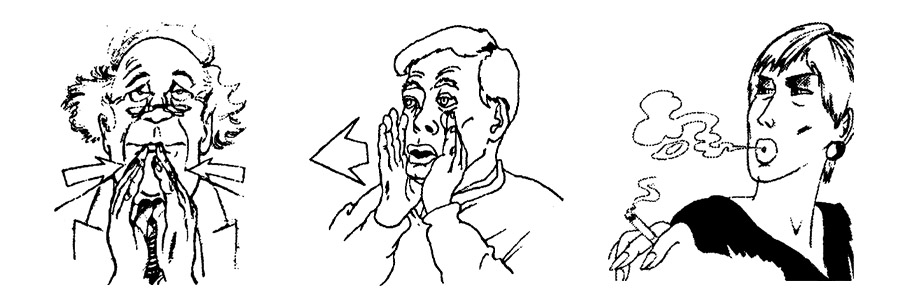
34 / to join the fingertips of both hands together, placing the tips of the index fingers on the lips
Thought, reflection.
35 / both hands cupped slightly to form a megaphone that surrounds the mouth on both sides
A useful gesture that accompanies a call of the voice.
36 / to blow the smoke from a cigarette in the direction of a person whom one desires
Flirtation. Amorous invitation.
Middle East.
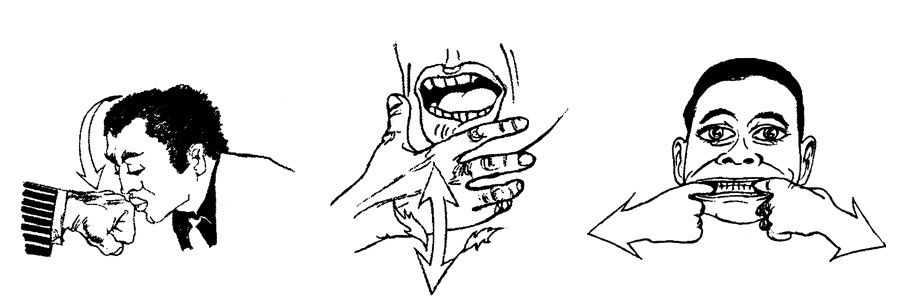
37 / to kiss the forehead of a superior; or the hand; or the foot
Respect.
Arab world.
The kiss of the young gangster on the fist of his Mafia godfather is a variant of this Mediterranean gesture.
38 / with fingers spread, to wave one’s hand in front of one’s mouth as if to fan it
A way of indicating that a dish is too hot or too spicy and is burning one’s mouth.
39 / both index fingers in the mouth, pulling its corners horizontally away from each other
One of the typical funny faces made by children. In 1971, American psychologist Paul Ekman distinguished seven primary meanings for the facial expressions: happiness, anger, surprise, sadness, disgust, contempt, and fear. Their manifestation is linked to the innervation of certain facial muscles. To these involuntary grimaces and facial expressions we must add those made voluntarily by children to mock or ridicule.
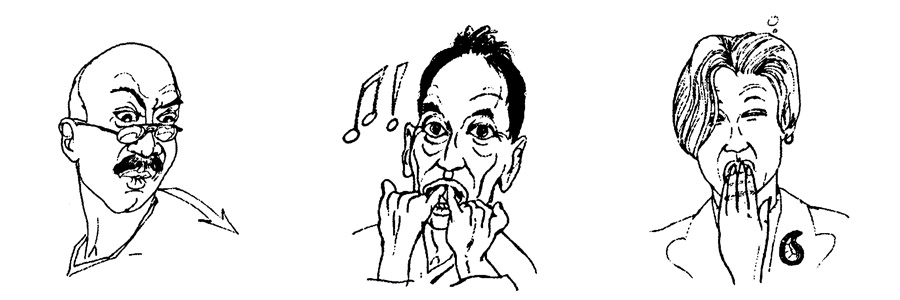
40 / to feign as if to spit on the ground
An insult directed at an interlocutor, profound contempt.
Mediterranean world.
41 / to whistle
While whistling isn’t a gesture, strictly speaking, neither is it an articulated language. We could classify here whistling addressed to a person at whom we are jeering, appreciative whistling aimed at a passing woman, a sudden whistle to call a person or animal (such as a dog) or intended as a signal, the whistle of a traffic controller, etc., with or without the aid of fingers.
42 / to feign a yawn, hand in front of one’s mouth
Boredom. “He is so boring with his long-winded speeches!”
François Caradec (1924–2008) was a French writer and a member of both the Collége de ‘Pataphysique and the Oulipo. His voluminous oeuvre includes biographies of Raymond Roussel and Alfred Jarry, as well as an encyclopedia of practical jokes and a dictionary of French slang. Caradec was a devoted specialist in Alphonse Allais, compiling and editing his collected works, and was one of the first historians of the bande dessinée in France. This article is excerpted from his book “Dictionary of Gestures.”
